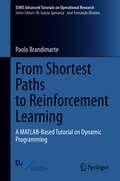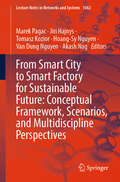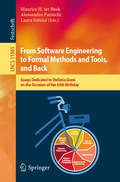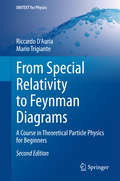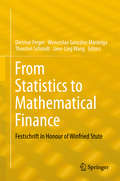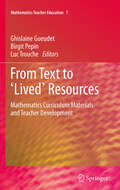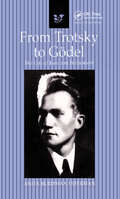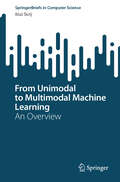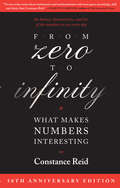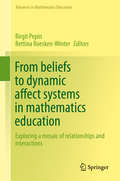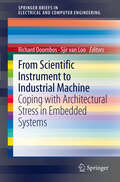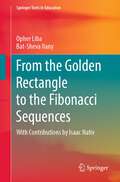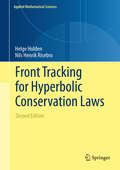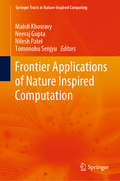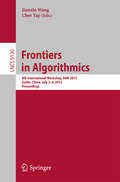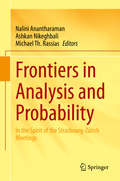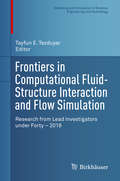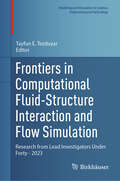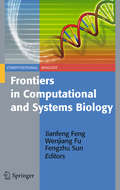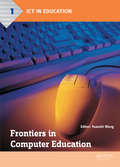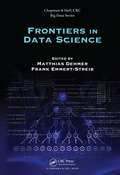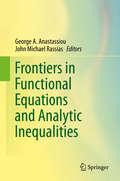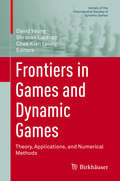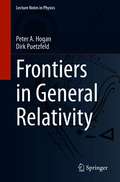- Table View
- List View
From Shortest Paths to Reinforcement Learning: A MATLAB-Based Tutorial on Dynamic Programming (EURO Advanced Tutorials on Operational Research)
by Paolo BrandimarteDynamic programming (DP) has a relevant history as a powerful and flexible optimization principle, but has a bad reputation as a computationally impractical tool. This book fills a gap between the statement of DP principles and their actual software implementation. Using MATLAB throughout, this tutorial gently gets the reader acquainted with DP and its potential applications, offering the possibility of actual experimentation and hands-on experience. The book assumes basic familiarity with probability and optimization, and is suitable to both practitioners and graduate students in engineering, applied mathematics, management, finance and economics.
From Smart City to Smart Factory for Sustainable Future: Conceptual Framework, Scenarios, and Multidiscipline Perspectives (Lecture Notes in Networks and Systems #1062)
by Marek Pagac Jiri Hajnys Tomasz Kozior Hoang-Sy Nguyen Van Dung Nguyen Akash NagThis volume includes the proceedings of the 2nd International Conference on "From Smart City to Smart Factory for a Sustainable Future" (SCFF24), held at VSB - Technical University of Ostrava from May 14 to 16, 2024. The conference was organized in collaboration with university and institute partners from Czech Republic, Poland, India, and Vietnam. SCFF24 covers a broad range of topics, with a particular focus on the application of technologies in Smart Cities and Smart Factories to achieve a Sustainable Future. The Conference aims to bring together participants from diverse fields to share their knowledge, innovative ideas, and solutions to current challenges that hinder progress toward a more modern and sustainable life that we all share. In light on this, it also serves as a platform for the mutual exchange of experiences and the formation of enduring international collaborations. This book offers a comprehensive and multi-perspective view, providing readers with insights into the latest technological possibilities from voices around the world, with the hope of raising awareness and fostering further advancements in these fields.
From Software Engineering to Formal Methods and Tools, and Back: Essays Dedicated to Stefania Gnesi on the Occasion of Her 65th Birthday (Lecture Notes in Computer Science #11865)
by Alessandro Fantechi Maurice H. ter Beek Laura SeminiThis volume was published in honor of Stefania Gnesi’s 65th birthday. The Festschrift volume contains 32 papers written by close collaborators and friends of Stefania and was presented to her on October 8, 2019 one-day colloquium held in Porto, Portugal, The Festschrift consists of eight sections, seven of which reflect the main research areas to which Stefania has contributed. Following a survey of Stefania's legacy in research and a homage by her thesis supervisor, these seven sections are ordered according to Stefania's life cycle in research, from software engineering to formal methods and tools, and back: Software Engineering; Formal Methods and Tools; Requirements Engineering; Natural Language Processing; Software Product Lines; Formal Verification; and Applications.
From Special Relativity to Feynman Diagrams
by Riccardo D'Auria Mario TrigianteThis book, now in its second edition, provides an introductory course on theoretical particle physics with the aim of filling the gap that exists between basic courses of classical and quantum mechanics and advanced courses of (relativistic) quantum mechanics and field theory. After a concise but comprehensive introduction to special relativity, key aspects of relativistic dynamics are covered and some elementary concepts of general relativity introduced. Basics of the theory of groups and Lie algebras are explained, with discussion of the group of rotations and the Lorentz and Poincaré groups. In addition, a concise account of representation theory and of tensor calculus is provided. Quantization of the electromagnetic field in the radiation range is fully discussed. The essentials of the Lagrangian and Hamiltonian formalisms are reviewed, proceeding from systems with a finite number of degrees of freedom and extending the discussion to fields. The final four chapters are devoted to development of the quantum field theory, ultimately introducing the graphical description of interaction processes by means of Feynman diagrams. The book will be of value for students seeking to understand the main concepts that form the basis of contemporary theoretical particle physics and also for engineers and lecturers. An Appendix on some special relativity effects is added.
From Statistics to Mathematical Finance
by Wenceslao González Manteiga Dietmar Ferger Thorsten Schmidt Jane-Ling WangThis book, dedicated to Winfried Stute on the occasion of his 70th birthday, presents a unique collection of contributions by leading experts in statistics, stochastic processes, mathematical finance and insurance. The individual chapters cover a wide variety of topics ranging from nonparametric estimation, regression modelling and asymptotic bounds for estimators, to shot-noise processes in finance, option pricing and volatility modelling. The book also features review articles, e. g. on survival analysis.
From Sugar to Splenda
by Bert Fraser-ReidMore than just coincidence connects a Tate & Lyle lawsuit and artificial sweetener to Jamaican-born Chemist Bert Fraser-Reid. From his first experience of Chemistry through his diabetic father, to his determination and drive as a Chemistry student in Canada, Fraser-Reid weaves a remarkable tale integrating science, law and autobiographical anecdotes. This book arises from the lawsuit brought by Tate & Lyle against companies accused of infringing its patents for sucralose, the sweet ingredient in the artificial sweetener SPLENDA which is made by chlorinating sugar. From a 1958 undergraduate intern witnessing the pioneering experiments on sugar chlorination, to being the 1991 recipient of the world's premiere prize for carbohydrate chemistry, Fraser-Reid was groomed for his role as expert witness in the mentioned lawsuit. Nevertheless, it seems more than his career links Fraser-Reid to the case.
From Text to 'Lived' Resources
by Ghislaine Gueudet Birgit Pepin Luc TroucheWhat kinds of curriculum materials do mathematics teachers select and use, and how? This question is complex, in a period of deep evolutions of teaching resources, with the proficiency of online resources in particular. How do teachers learn from these materials, and in which ways do they 'tailor' them for their use and pupil learning? Teachers collect resources, select, transform, share, implement, and revise them. Drawing from the French term « ingénierie documentaire »,we call these processes « documentation ». The literal English translation is « to work with documents », but the meaning it carries is richer. Documentation refers to the complex and interactive ways that teachers work with resources; in-class and out-of-class, individually, but also collectively.
From Trotsky to Gödel: The Life of Jean van Heijenoort
by Anita Burdman FefermanThis story of a highly intelligent observer of the turbulent 20th century who was intimately involved as the secretary and bodyguard to Leon Trotsky is based on extensive interviews with the subject, Jean van Heijenoort, and his family, friends, and colleagues. The author has captured the personal drama and the professional life of her protagonist--ranging from the political passion of a young intellectual to the scientific and historic work in the most abstract and yet philosophically important area of logic--in a very readable narrative.
From Unimodal to Multimodal Machine Learning: An Overview (SpringerBriefs in Computer Science)
by Blaž ŠkrljWith the increasing amount of various data types, machine learning methods capable of leveraging diverse sources of information have become highly relevant. Deep learning-based approaches have made significant progress in learning from texts and images in recent years. These methods enable simultaneous learning from different types of representations (embeddings). Substantial advancements have also been made in joint learning from different types of spaces. Additionally, other modalities such as sound, physical signals from the environment, and time series-based data have been recently explored. Multimodal machine learning, which involves processing and learning from data across multiple modalities, has opened up new possibilities in a wide range of applications, including speech recognition, natural language processing, and image recognition.From Unimodal to Multimodal Machine Learning: An Overview gradually introduces the concept of multimodal machine learning, providing readers with the necessary background to understand this type of learning and its implications. Key methods representative of different modalities are described in more detail, aiming to offer an understanding of the peculiarities of various types of data and how multimodal approaches tend to address them (although not yet in some cases). The book examines the implications of multimodal learning in other domains and presents alternative approaches that offer computationally simpler yet still applicable solutions. The final part of the book focuses on intriguing open research problems, making it useful for practitioners who wish to better understand the limitations of existing methods and explore potential research avenues to overcome them
From Zero to Infinity: What Makes Numbers Interesting
by Constance ReidFrom Zero to Infinity is a combination of number lore, number history, and sparkling descriptions of the simply stated but exceedingly difficult problems posed by the most ordinary numbers that first appeared in 1955 and has been kept in print continuously ever since.
From beliefs to dynamic affect systems in mathematics education
by Birgit Pepin Bettina Roesken-WinterThis book connects seminal work in affect research and moves forward to provide a developing perspective on affect as the "decisive variable" of the mathematics classroom. In particular, the book contributes and investigates new conceptual frameworks and new methodological 'tools' in affect research and introduces the new field of 'collectives' to explore affect systems in diverse settings. Investigated by internationally renowned scholars, the book is build up in three dimensions. The first part of the book provides an overview of selected theoretical frames - theoretical lenses - to study the mosaic of relationships and interactions in the field of affect. In the second part the theory is enriched by empirical research studies and provides relevant findings in terms of developing deeper understandings of individuals' and collectives' affective systems in mathematics education. Here pupil and teacher beliefs and affect systems are examined more closely. The final part investigates the methodological tools used and needed in affect research. How can the different methodological designs contribute data which help us to develop better understandings of teachers' and pupils' affect systems for teaching and learning mathematics and in which ways are knowledge and affect related?
From scientific instrument to industrial machine
by Sjir Van Loo Richard DoornbosArchitectural stress is the inability of a system design to respond to new market demands. It is an important yet often concealed issue in high tech systems. In From scientific instrument to industrial machine, we look at the phenomenon of architectural stress in embedded systems in the context of a transmission electron microscope system built by FEI Company. Traditionally, transmission electron microscopes are manually operated scientific instruments, but they also have enormous potential for use in industrial applications. However, this new market has quite different characteristics. There are strong demands for cost-effective analysis, accurate and precise measurements, and ease-of-use. These demands can be translated into new system qualities, e.g. reliability, predictability and high throughput, as well as new functions, e.g. automation of electron microscopic analyses, automated focusing and positioning functions. From scientific instrument to industrial machine takes a pragmatic approach to the problem of architectural stress. In particular, it describes the outcomes of the Condor project, a joint endeavour by a consortium of industrial and academic partners. In this collaboration an integrated approach was essential to successfully combine various scientific results and show the first steps towards a new direction. System modelling and prototyping were the key techniques to develop better understanding and innovative solutions to the problems associated with architectural stress. From scientific instruments to industrial machine is targeted mainly at industrial practitioners, in particular system architects and engineers working on high tech systems. It can therefore be read without particular knowledge of electron microscope systems or microscopic applications. The book forms a bridge between academic and applied science, and high tech industrial practice. By showing the approaches and solutions developed for the electron microscope, it is hoped that system designers will gain some insights in how to deal with architectural stress in similar challenges in the high tech industry.
From the Golden Rectangle to the Fibonacci Sequences (Springer Texts in Education)
by Bat-Sheva Ilany Opher LibaThe book takes us on a fascinating journey through one of the most beautiful and fascinating topics of mathematics. It presents a wealth of information about the golden ratio and the Fibonacci sequence. The book introduces the reader to novel perspectives to classic mathematical concepts and problems. The book’s structure engages with the reader actively, leading to more profound understanding, satisfaction and deep insights in learning mathematics. The book strengthens and expands the readers' mathematical knowledge, allowing them a glimpse of several advanced academic concepts. It demonstrates and instils the essence of mathematical research, along the lines of George Polya: observation, conjecture, proof, implementation, generalization and raising new questions.
Front Tracking for Hyperbolic Conservation Laws
by Helge Holden Nils Henrik RisebroThis is the second edition of a well-received book providing the fundamentals of the theory hyperbolic conservation laws. Several chapters have been rewritten, new material has been added, in particular, a chapter on space dependent flux functions and the detailed solution of the Riemann problem for the Euler equations. Hyperbolic conservation laws are central in the theory of nonlinear partial differential equations and in science and technology. The reader is given a self-contained presentation using front tracking, which is also a numerical method. The multidimensional scalar case and the case of systems on the line are treated in detail. A chapter on finite differences is included. From the reviews of the first edition: "It is already one of the few best digests on this topic. The present book is an excellent compromise between theory and practice. Students will appreciate the lively and accurate style. " D. Serre, MathSciNet "I have read the book with great pleasure, and I can recommend it to experts as well as students. It can also be used for reliable and very exciting basis for a one-semester graduate course. " S. Noelle, Book review, German Math. Soc. "Making it an ideal first book for the theory of nonlinear partial differential equations. . . an excellent reference for a graduate course on nonlinear conservation laws. " M. Laforest, Comp. Phys. Comm.
Frontier Applications of Nature Inspired Computation (Springer Tracts in Nature-Inspired Computing)
by Neeraj Gupta Tomonobu Senjyu Mahdi Khosravy Nilesh PatelThis book addresses the frontier advances in the theory and application of nature-inspired optimization techniques, including solving the quadratic assignment problem, prediction in nature-inspired dynamic optimization, the lion algorithm and its applications, optimizing the operation scheduling of microgrids, PID controllers for two-legged robots, optimizing crane operating times, planning electrical energy distribution systems, automatic design and evaluation of classification pipelines, and optimizing wind-energy power generation plants. The book also presents a variety of nature-inspired methods and illustrates methods of adapting these to said applications. Nature-inspired computation, developed by mimicking natural phenomena, makes a significant contribution toward the solution of non-convex optimization problems that normal mathematical optimizers fail to solve. As such, a wide range of nature-inspired computing approaches has been used in multidisciplinary engineering applications. Written by researchers and developers from a variety of fields, this book presents the latest findings, novel techniques and pioneering applications.
Frontiers in Algorithmics
by Jianxin Wang Chee YapThis book constitutes the proceedings of the 9th International Workshop on Frontiers in Algorithmics, FAW 2015, held in Guilin, China, in July 2015. The 28 papers presented in this volume were carefully reviewed and selected from 65 submissions. They deal with graph algorithms, approximation algorithms, combinatorial optimization, parameterized algorithms, and online algorithms.
Frontiers in Analysis and Probability: In the Spirit of the Strasbourg-Zürich Meetings
by Michael Th. Rassias Ashkan Nikeghbali Nalini AnantharamanThe volume presents extensive research devoted to a broad spectrum of mathematical analysis and probability theory. Subjects discussed in this Work are those treated in the so-called Strasbourg–Zürich Meetings. These meetings occur twice yearly in each of the cities, Strasbourg and Zürich, venues of vibrant mathematical communication and worldwide gatherings. The topical scope of the book includes the study of monochromatic random waves defined for general Riemannian manifolds, notions of entropy related to a compact manifold of negative curvature, interacting electrons in a random background, lp-cohomology (in degree one) of a graph and its connections with other topics, limit operators for circular ensembles, polyharmonic functions for finite graphs and Markov chains, the ETH-Approach to Quantum Mechanics, 2-dimensional quantum Yang–Mills theory, Gibbs measures of nonlinear Schrödinger equations, interfaces in spectral asymptotics and nodal sets. Contributions in this Work are composed by experts from the international community, who have presented the state-of-the-art research in the corresponding problems treated. This volume is expected to be a valuable resource to both graduate students and research mathematicians working in analysis, probability as well as their interconnections and applications.
Frontiers in Computational Fluid-Structure Interaction and Flow Simulation: Research From Lead Investigators Under Forty - 2018 (Modeling and Simulation in Science, Engineering and Technology)
by Tayfun E. TezduyarComputational fluid-structure interaction and flow simulation are challenging research areas that bring solution and analysis to many classes of problems in science, engineering, and technology. Young investigators under the age of 40 are conducting much of the frontier research in these areas, some of which is highlighted in this book. The first author of each chapter took the lead role in carrying out the research presented. The topics covered include Computational aerodynamic and FSI analysis of wind turbines,Simulating free-surface FSI and fatigue-damage in wind-turbine structural systems,Aorta flow analysis and heart valve flow and structure analysis,Interaction of multiphase fluids and solid structures,Computational analysis of tire aerodynamics with actual geometry and road contact, andA general-purpose NURBS mesh generation method for complex geometries.This book will be a valuable resource for early-career researchers and students — not only those interested in computational fluid-structure interaction and flow simulation, but also other fields of engineering and science, including fluid mechanics, solid mechanics and computational mathematics – as it will provide them with inspiration and guidance for conducting their own successful research. It will also be of interest to senior researchers looking to learn more about successful research led by those under 40 and possibly offer collaboration to these researchers.
Frontiers in Computational Fluid-Structure Interaction and Flow Simulation: Research from Lead Investigators Under Forty - 2023 (Modeling and Simulation in Science, Engineering and Technology)
by Tayfun E. TezduyarComputational fluid-structure interaction (FSI) and flow simulation are challenging research areas that bring solution and analysis to many classes of problems in science, engineering, and technology. Young investigators under the age of 40 are conducting much of the frontier research in these areas, some of which is highlighted in this volume. The first author of each chapter took the lead role in carrying out the research presented. Some of the topics explored includeDirect flow simulation of objects represented by point cloudsComputational investigation of leaflet flutter in thinner biological heart valve tissuesHigh-fidelity simulation of hydrokinetic energy applicationsHigh-resolution isogeometric analysis of car and tire aerodynamicsComputational analysis of air-blast-structure interactionHeart valve computational flow analysis with boundary layer and leaflet contact representationComputational thermal multi-phase flow for metal additive manufacturingThis volume will be a valuable resource for early-career researchers and students — not only those interested in computational FSI and flow simulation, but also other fields of engineering and science, including fluid mechanics, solid mechanics, and computational mathematics – as it will provide them with inspiration and guidance for conducting their own successful research. It will also be of interest to senior researchers looking to learn more about successful research led by those under 40 and possibly offer collaboration to these researchers.
Frontiers in Computational and Systems Biology
by Jianfeng Feng Wenjiang Fu Fengzhu SunThis unique volume surveys state-of-the-art research on statistical methods in molecular and systems biology, with contributions from leading experts in the field. Each chapter discusses theoretical aspects, applications to biological problems, and possible future developments. Topics and features: presents the use of thermodynamic models to analyze gene regulatory mechanisms; reviews major algorithms for RNA secondary structure prediction; discusses developments in the area of oligo arrays; examines the application of models of stochastic processes in nonequilibrium thermodynamics and biological signal transduction; describes phylogenetic footprinting methods for TFBS identification; introduces penalized regression-based methods for constructing genetic interaction or regulatory networks; investigates the specific role played by irreversible Markov processes in modeling cellular biochemical systems; explores the concept of gene modules in a transcriptional regulatory network.
Frontiers in Computer Education: Proceedings of the 2nd International Conference on Frontiers in Computer Education (ICFCE 2014), Wuhan, China, December 24-25, 2014
by Yuanzhi WangThis proceedings volume contains selected papers presented at the 2014 International Conference on Frontiers in Computer Education (ICFCE 2014), which was held December 24-25, 2014, in Wuhan, China. The objective of this conference was to provide a forum for different researchers in different fields, especially Computer Education as well as Information Technology, to exchange their various findings. The papers have been grouped under the following overarching themes: Computer Science, Computer Education, Education and Teaching Reform, and Communication and Intelligent Control.
Frontiers in Data Science (Chapman & Hall/CRC Big Data Series)
by Matthias Dehmer and Frank Emmert-StreibFrontiers in Data Science deals with philosophical and practical results in Data Science. A broad definition of Data Science describes the process of analyzing data to transform data into insights. This also involves asking philosophical, legal and social questions in the context of data generation and analysis. In fact, Big Data also belongs to this universe as it comprises data gathering, data fusion and analysis when it comes to manage big data sets. A major goal of this book is to understand data science as a new scientific discipline rather than the practical aspects of data analysis alone.
Frontiers in Functional Equations and Analytic Inequalities
by George A. Anastassiou John Michael RassiasThis volume presents cutting edge research from the frontiers of functional equations and analytic inequalities active fields. It covers the subject of functional equations in a broad sense, including but not limited to the following topics: Hyperstability of a linear functional equation on restricted domainsHyers–Ulam’s stability results to a three point boundary value problem of nonlinear fractional order differential equationsTopological degree theory and Ulam’s stability analysis of a boundary value problem of fractional differential equationsGeneral Solution and Hyers-Ulam Stability of Duo Trigintic Functional Equation in Multi-Banach SpacesStabilities of Functional Equations via Fixed Point TechniqueMeasure zero stability problem for the Drygas functional equation with complex involutionFourier Transforms and Ulam Stabilities of Linear Differential EquationsHyers–Ulam stability of a discrete diamond–alpha derivative equationApproximate solutions of an interesting new mixed type additive-quadratic-quartic functional equation. The diverse selection of inequalities covered includes Opial, Hilbert-Pachpatte, Ostrowski, comparison of means, Poincare, Sobolev, Landau, Polya-Ostrowski, Hardy, Hermite-Hadamard, Levinson, and complex Korovkin type. The inequalities are also in the environments of Fractional Calculus and Conformable Fractional Calculus. Applications from this book's results can be found in many areas of pure and applied mathematics, especially in ordinary and partial differential equations and fractional differential equations. As such, this volume is suitable for researchers, graduate students and related seminars, and all science and engineering libraries. The exhibited thirty six chapters are self-contained and can be read independently and interesting advanced seminars can be given out of this book.
Frontiers in Games and Dynamic Games: Theory, Applications, and Numerical Methods (Annals of the International Society of Dynamic Games #16)
by David Yeung Shravan Luckraz Chee Kian LeongThis contributed volume presents the state-of-the-art of games and dynamic games, featuring several chapters based on plenary sessions at the ISDG-China Chapter Conference on Dynamic Games and Game Theoretic Analysis, which was held from August 3-5, 2017 at the Ningbo campus of the University of Nottingham, China. The chapters in this volume will provide readers with paths to further research, serving as a testimony to the vitality of the field. Experts cover a range of theory and applications related to games and dynamic games, with topics including:Dynamically stable cooperative provision of public goods under non-transferable utilityStrongly time-consistent solutions in cooperative dynamic gamesIncentive Stackelberg games for stochastic systemsStatic and inverse Stackelberg games in political economyCournot and Betrand competition on symmetric R&D networksNumerical Nash equilibria using curvilinear multistart algorithmMarkov chain approximation numerical scheme for infinite-horizon mean field gamesFrontiers in Games and Dynamic Games will appeal to an interdisciplinary audience of researchers, practitioners, and graduate students interested in games and dynamic games.
Frontiers in General Relativity (Lecture Notes in Physics #984)
by Dirk Puetzfeld Peter A. HoganThis book discusses some of the open questions addressed by researchers in general relativity. Photons and particles play important roles in the theoretical framework, since they are involved in analyzing and measuring gravitational fields and in constructing mathematical models of gravitational fields of various types. The authors highlight this aspect covering topics such as the construction of models of Bateman electromagnetic waves and analogous gravitational waves, the studies of gravitational radiation in presence of a cosmological constant and the gravitational compass or clock compass for providing an operational way of measuring a gravitational field. The book is meant for advanced students and young researchers in general relativity, who look for an updated text which covers in depth the calculations and, equally, takes on new challenges. The reader, along the learning path, is stimulated by provocative examples interspersed in the text that help to find novel representations of the uses of particles and photons.
